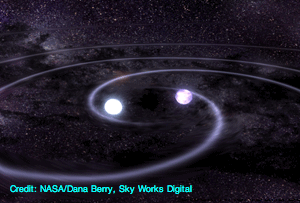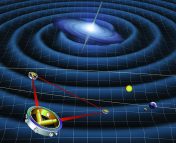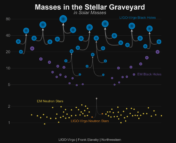- Title: Galaxy Survey On The Fly: Prospects of Rapid Galaxy Cataloging to Aid the Electromagnetic Follow-up of Gravitational-wave Observations
- Authors: I. Bartos, A. P. S. Crotts, S. Marka.
- First author’s institution: Columbia University, USA.
Gravitational waves are ripples in space-time that occur, for example, when two very compact celestial bodies merge. Their direct detection would allow scientists to characterize these mergers and understand the physics of systems undergoing strong gravitational interactions. Perhaps that era is not so distant; gravitational wave detectors such as advanced LIGO and Virgo are expected to come online by 2016. While this is a very exciting prospect, gravitational wave detectors have limited resolution; they can constrain the location of the source to within an area of 10 to 1000 deg2 on the sky, depending on the number of detectors and the strength of the signal.
To understand the nature of the source of gravitational waves, scientists hope to be able to locate it more accurately by searching for its electromagnetic counterpart immediately after the gravitational wave is detected. How can telescopes help in this endeavor? The authors of this paper explore the possibility of performing very fast galaxy surveys to identify and characterize the birthplace of gravitational waves.
Gravitational waves from the merger of two neutron stars can be detected out to 200 Mpc, which is roughly 800 times the distance to the Andromeda galaxy. It is expected that LIGO-Virgo will detect about 40 of these events per year. There are roughly 8 galaxies per 1 deg2 within 200 Mpc – that is 800 candidate galaxies in an area of 100 deg2. Hence, a quick survey that would pinpoint those possible galaxy counterparts to the gravitational wave emission would be very useful. After potential hosts are identified, they could be followed-up with telescopes with smaller fields-of-view to measure the light emitted by the source of gravitational waves.
The electromagnetic emission following the gravitational wave detection only lasts for short periods of time (for a kilonova, the timescale is of approximately a week), and this drives the need for fast surveys. To devise an efficient search strategy, the authors suggest looking for galaxies with high star formation rates. It is expected that those galaxies will have higher chances of hosting a gravitational wave event. (Although they clarify that the rate of mergers of compact objects might be better correlated with the mass of the galaxy rather than its star formation activity.) A good proxy for star formation in a galaxy is the light it emits in the red H-alpha line, coming from hydrogen atoms in clouds of gas that act as stellar nurseries. The issue is whether current telescopes can survey large areas fast enough to find a good fraction of all star forming galaxies within the detection area of LIGO-Virgo.
The authors consider a 2m-size telescope and estimate the typical observing time needed to identify a typical star forming galaxy up to a distance of 200 Mpc. This ranges from 40-80 seconds depending on the observing conditions. It would take this type of telescope a week to cover 100 deg2. This result matches very well the expected duration of the visible light signal from these events! Mergers of black holes and neutron stars could be detected out to larger distances (~450 Mpc). To find possible galaxy hosts out to these distances, a 2m-class telescope would cover 30 deg2 in a week. Without a doubt, the exciting prospect of gravitational wave detection will spur more detailed searches for the best strategies to locate their sources.






Trackbacks/Pingbacks